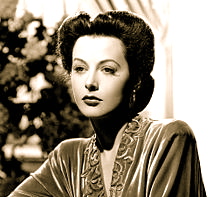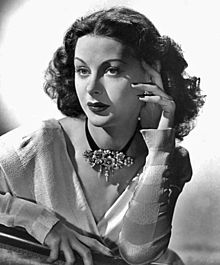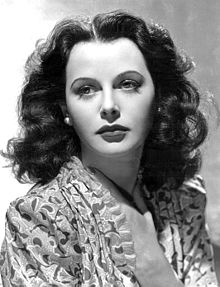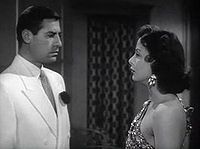Hedy Lamarr

Hedy Lamarr: Movie star, inventor of WiFi

Hollywood is a place where folks are often recognized more for their looks than their talent – and actress Hedy Lamarr was no exception. But it’s what she invented in her spare time – to help end that war – that has history turning a kinder eye, linking her to a bombshell of a whole different sort, Lee Cowan reports.
in Algiers, (1938)
Hedy Lamarr (![]() /ˈhɛdi/; 9 November 1913 – 19 January 2000) was an Austrian-born American actress, celebrated for her great beauty, who was a major contract star of MGM‘s “Golden Age”. When she worked with Max Reinhardt in Berlin, he called her the “most beautiful woman in Europe” due to her “strikingly dark exotic looks”, a sentiment widely shared by her audiences and critics. She gained fame after starring in Gustav Machatý‘s Ecstasy, a film which featured closeups of her character during orgasm in one scene, as well as full frontal nude shots of her in another scene, both very unusual for the socially conservative period in which the bulk of her career took place.
/ˈhɛdi/; 9 November 1913 – 19 January 2000) was an Austrian-born American actress, celebrated for her great beauty, who was a major contract star of MGM‘s “Golden Age”. When she worked with Max Reinhardt in Berlin, he called her the “most beautiful woman in Europe” due to her “strikingly dark exotic looks”, a sentiment widely shared by her audiences and critics. She gained fame after starring in Gustav Machatý‘s Ecstasy, a film which featured closeups of her character during orgasm in one scene, as well as full frontal nude shots of her in another scene, both very unusual for the socially conservative period in which the bulk of her career took place.
Mathematically talented, Lamarr also co-invented—with composer George Antheil—an early technique for spread spectrum communications and frequency hopping, necessary for wirelesscommunication from the pre-computer age to the present day.
Early life
Lamarr was born Hedwig Eva Maria Kiesler in Vienna, Austria-Hungary, the only child of assimilated Jewish parents. Her mother, Gertrud (née Lichtwitz), was a pianist and Budapest native who came from the “Jewish haute bourgeoisie“, and her father, Lemberg-born Emil Kiesler, was a successful bank director.
She studied ballet and piano at age 10 – Career
In early 1933 she starred in Gustav Machatý‘s notorious film Ecstasy, a Czechoslovak film made in Prague, in which she played the love-hungry young wife of an indifferent older husband. Closeups of her face during orgasm in one scene and full frontal nude shots of her in another scene, swimming and running nude through the woods, gave the film great notoriety.
On August 10, 1933, aged 19, she married Friedrich Mandl, a Vienna-based arms manufacturer 13 years her senior. In her autobiography Ecstasy and Me, Lamarr described Mandl as an extremely controlling man who sometimes tried to keep her shut up in their mansion. Mandl bought as many copies of Ecstasy as he could possibly find, objecting to her in the film, and “the expression on her face.” (Lamarr in her autobiography, objecting to the rumors about real sex, admitted that her costar had indeed played the scene with her using “method acting reality,” but she also stated that the film’s director had simulated looks of passion from offscreen by poking her in the bottom with a safety pin).
Mandl prevented her from pursuing her acting career, and instead took her to meetings with technicians and business partners. In these meetings, the mathematically talented Lamarr learned about military technology. Otherwise she had to stay at their castle home, Schloss Schwarzenau. She later related that, although Mandl was part-Jewish, he consorted with Nazi industrialists. InEcstasy and Me, Lamarr wrote that Benito Mussolini and Adolf Hitler attended Mandl’s grand parties. She related that in 1937 she disguised herself as one of her maids and fled to Paris, where she obtained a divorce, and then moved to London. According to another version of the episode, she persuaded Mandl to allow her to attend a party wearing all her expensive jewelry, later drugged him with the help of her maid, and made her escape out of the country with the jewelry.
Hollywood
 Lamarr in The Conspirators (1944)
Lamarr in The Conspirators (1944)
First she went to Paris, then met Louis B. Mayer in London. After he hired her, at his insistence, she changed her name to Hedy Lamarr, choosing the surname in homage to a beautiful film star of the silent era, Barbara La Marr,[8] who had died in 1926 from tuberculosis.
In Hollywood, she was usually cast as glamorous and seductive. Her American debut was inAlgiers (1938). Her many films include Boom Town (1940) with Clark Gable and Spencer Tracy,Comrade X with Gable, White Cargo (1942), and Tortilla Flat (1942) with Tracy and John Garfield, based on the novel by John Steinbeck. White Cargo, one of Lamarr’s biggest hits at MGM, contains arguably her most famous film quote, “I am Tondelayo. I make tiffin for you?” In 1941, she was cast alongside two other Hollywood beauties, Lana Turner and Judy Garland in the musical extravaganza Ziegfeld Girl.
Lamarr made 18 films from 1940 to 1949 even though she had two children during that time (in 1945 and 1947). After leaving MGM in 1945, she enjoyed her biggest success as Delilah in Cecil B. DeMille‘s Samson and Delilah, the highest-grossing film of 1949, with Victor Mature as theBiblical strongman. However, following her comedic turn opposite Bob Hope in My Favorite Spy(1951), her career went into decline. She appeared only sporadically in films after 1950, one of her last roles being that of Joan of Arc in Irwin Allen‘s critically panned epic The Story of Mankind(1957).
Later years
The 1970s were a decade of increasing seclusion for Lamarr. She was offered several scripts, television commercials, and stage projects, but none inspired her interest. In 1974, Lamarr filed an invasion of privacy lawsuit to the tune of $10 million for the unauthorized use of her name in the Mel Brooks satire Blazing Saddles; the case was settled out of court. Tired of the life of a celebrity and with her eyesight failing, Lamarr retreated from public life and settled in Miami Beach, Florida, in 1981.
For her contribution to the motion picture industry, Hedy Lamarr has a star on the Hollywood Walk of Fame at 6247 Hollywood Blvd.
Personal life
 Lamarr became a naturalized citizen of the United States on April 10, 1953.
Lamarr became a naturalized citizen of the United States on April 10, 1953.
Marriages and romances
She was briefly engaged to German actor Fred Doederlein, and later to actor George Montgomeryin 1942.
Lamarr was married six times:
- Friedrich Mandl (1900–1977), married 1933–1937; chairman of Hirtenberger Patronen-Fabrik, a leading armaments firm founded by his father, Alexander Mandl. Mandl, partially of Jewish descent, was a supporter of Austrofascism, although not Nazism.
- Gene Markey (1895–1980), screenwriter and producer, married 1939–1941; When Lamarr and Markey divorced – she said they had only spent four evenings alone together in their marriage – the judge advised her to get to know any future husband longer than the four weeks she had known Markey.
- John Loder (born John Muir Lowe, 1898–1988), actor, married 1943–47;
- Ernest “Ted” Stauffer (1909–1991), nightclub owner, restaurateur, and former bandleader, married 1951–1952.
- W. Howard Lee (1909–1981), a Texas oilman, married 1953–1960. He later married film star Gene Tierney.
- Lewis J. Boies (b. 1920), a lawyer (her divorce lawyer), married 1963–1965.
These marriages produced 6 children, several of whom were adopted: From husband Friedrich Mandle there was
- John MandlJuly 14, 1934 (age 78) in Vienna, Austria
- George MandlDecember 4, 1936 (age 75) in Vienna, Austria
From husband Gene Markey
- James Lamarr MarkeyJanuary 9, 1939 (age 73) in Los Angeles – was adopted on June 12, 1939. James was later adopted again by Hedy’s next husband, John Loder, who then his name to James Lamarr Markey Loder. James challenged his mother’s will in 2000, because it did not mention him but dropped the suit in exchange for a lump-sum payment of $50,000 (reportedly).
From John Loder
- Denise LoderJanuary 19, 1945 (age 67) in Holmby Hills
- Antony LoderFebruary 1, 1947 (age 65) in Holmby Hills. Anthony, is featured in the European documentary film Calling Hedy Lamarr (2004).
and finally from a one year marriage to Ernest “Ted” Stauffer
- Joanne StaufferJune 19, 1949 (age 63) in Holmby Hills -adopted on January 3, 1952.
Controversies
In 1966, Lamarr was arrested for shoplifting in Los Angeles. The charges were eventually dropped. In 1991, she was arrested on the same charge in Florida, this time for $21.48 worth of laxatives and eye drops. She pleaded “no contest” to avoid a court appearance, and in return for a promise to refrain from breaking any laws for a year, the charges were once again dropped.
According to her autobiography, Ecstasy and Me (1966), once while running away from Friedrich Mandl, she slipped into a brothel and hid in an empty room. While her husband searched the brothel, a man entered the room and she had sex with him so she could remain hidden. She was finally successful in escaping when she hired a new maid who resembled her; she drugged the maid and used her uniform as a disguise to escape. Lamarr later sued the publisher, saying that many of the anecdotes in the book, which was described by a judge as “filthy, nauseating, and revolting”, were fabricated by its ghost writer, Leo Guild. She was also sued in Federal Court by Gene Ringgold, who asserts that the actress’s autobiography contains material from an article he wrote about her for a magazine Screen Facts in 1965.
For several years beginning in 1997, the boxes of CorelDRAW‘s software suites were graced by a large Corel-drawn image of Hedy Lamarr. The picture won CorelDRAW’s yearly software suite cover design contest in 1996. Lamarr sued Corel for using the image without her permission. Corel countered that she did not own rights to the image. The parties reached an undisclosed settlement in 1998.
Death
 John Hodiak and Lamarr in A Lady Without Passport (1950)
John Hodiak and Lamarr in A Lady Without Passport (1950)
Lamarr died in Casselberry, Florida, on January 19, 2000, aged 86, from natural causes. Her son Anthony Loder took her ashes to Austria and spread them in the Vienna Woods, in accordance with her last wishes.



